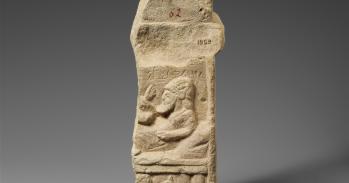
A rare medieval painting depicting Judas’ betrayal of Christ may have survived destruction at the hands of 16th century iconoclasts after being ‘recycled’ to list the Ten Commandments instead.
A rare medieval painting depicting Judas’ betrayal of Christ may have survived destruction at the hands of 16th century iconoclasts after being ‘recycled’ to list the Ten Commandments instead.
We cannot know for sure why the painting was re-used in this fashion.
Lucy Wrapson
Now on display at the Fitzwilliam Museum, The Kiss of Judas, is one of the rarest artworks of its type. At the time of the Reformation and during the English Civil War, church paintings were destroyed in their thousands. Few survive across the UK and of those that remain, many have been defaced. It is believed that up to 97% of English religious art was destroyed during and after the Reformation.
The brightly-painted wooden panel, with details picked out in silver and gold leaf, dates from c.1460, is all the more astonishing as it depicts the moment of Christ’s betrayal, by Judas Iscariot. Devout Catholic parishioners often scratched and gouged at the hated figure of Judas, so the painting would have been at risk from Catholic and Protestant congregations alike during the intervening centuries.
The remarkable discovery of the painting’s double life was revealed when it was purchased by the Fitzwilliam Museum in 2012 from the Church of St Mary, Grafton Regis, Northamptonshire. The church did not have the funds to conserve the work and maintain it in appropriate environmental conditions.
When the panel arrived at the Fitzwilliam’s Hamilton Kerr Institute for conservation, it had a considerable layer of surface dirt, bat faeces and heavily discoloured varnish which made it difficult to see the image.
But, it was a discovery on the back of the boards that revealed the remarkable story of how the painting survived.
The reverse was covered with a more modern backing board of plywood. When conservator Dr Lucy Wrapson removed this, she found the back of the planks making up the painting had, under close inspection, faint traces of writing. 16th century lettering was revealed using infra-red photography, proving the painting had been recycled at the time of the Reformation, the offending image turned around and the back converted into a painted board. It is thought that it may have listed the Ten Commandments, typical of a Protestant church furnishing.
Dr Wrapson said: “We cannot know for sure why the painting was re-used in this fashion, perhaps it was simple economy, reversed so it could still fit the space for which it was intended. Or perhaps it could have been deliberately saved. The painting is fascinating, and conservation and cleaning has revealed the vibrant original medieval colours.”
The painting was dated by dendrochronologist Ian Tyers. The panel is made up of boards imported to England from the eastern Baltic, Ian looked at the growth rings and identified the tree was felled after 1423 and estimated a usage date of c.1437-1469. Further non-invasive X-ray analysis and assessment using infra-red and ultraviolet light identified details, pigments and possible areas of fragility. Cleaning, protection of the wood from further insect damage, and a new layer of modern varnish have preserved the object for generations to come.
The painting is on display in the Rothschild Gallery of medieval works in the Fitzwilliam Museum. Funds from the sale will now help fix the roof of St Mary’s. Entry to the museum is free.

The text in this work is licensed under a Creative Commons Attribution 4.0 International License. For image use please see separate credits above.







